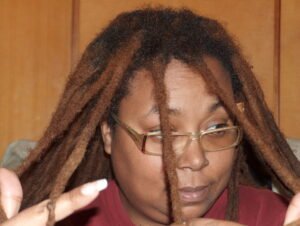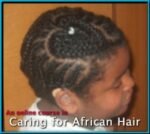 These are frequently asked questions about cornrows, African and natural hairstyling, and African self care and beauty.
These are frequently asked questions about cornrows, African and natural hairstyling, and African self care and beauty.
Cornrows
- When I braid cornrows, they are loose, messy, and won’t lay flat. Where did I go wrong?
- Are cornrows and plaits haram (forbidden) for Muslims? Do I have to undo them for wudu or ghusl?
- How do I care for cornrows once they are in? Can I wash my hair with cornrows?
- How long can cornrows stay in the hair?
- What length does my hair need to be in order to wear cornrows?
- Can people with straight hair wear cornrows?
- How do I braid cornrows?
- What are cornrows?
When I braid cornrows, they are loose, messy, and won’t lay flat. Where did I go wrong?
It’s normal for beginners to have this problem, so don’t look at it as something wrong as much as it is something new. It just takes some time to get used to, and learning when to tug a little and when to loosen up is an individual thing that comes with time.
What may be helpful though, is to consider that just like crochet or cross stitch, cornrowing is a similar craft. If you were braiding a rug by hand, you would want it on your lap or on your table, and have it at an angle where your hands could do the working while your arms are just there for support.
So try sitting down and turning the practice head at an angle that you are braiding towards yourself. Your arms can start out somewhat extended, but as you’re getting further along the row, your arms should be moving closer to your body. This is ergonomically better than trying to do the entire braid with the arms held up away from the body.
Also, there is some relation between the width of the row, the thickness of the hair, and how much hair you should pick up when you’re adding to the middle strand. Remember that it’s not an exact science. Sometimes you’ll need to leave some slack, and then start picking up after one or two regular stitches. Go with the shape of the head. Around curves is where people usually need to make some slack.
Back to Index
Are cornrows and plaits haram (forbidden) for Muslims? Do I have to undo them for wudu or ghusl?
Cornrows and braids are not haram at all for Muslims in general, but customs vary in some sects. However, there are different rules for men and women in this.
Women do not have to undo their cornrows for wudu or ghusl, but proper dry ablution must still be done for wudu. For ghusl, a woman must be sure that water wets all of the roots of her hair.
Men on the other hand, must undo their braids for ghusl. This means after every marital relation with their wives or at least every Friday during the ghusl before Jumuah. So simpler styles are recommended for men who wish to wear braids.
I’ve been told by a local African Muslim woman in Israel, that women in her sect are required to undo their braids during menstruation. Braids have nothing to do with observance or general ritual purity though. So ask your local Muslim women whether or not one is okay to pray in braids at their mosque.
Back to Index
How do I care for cornrows once they are in? Can I wash my hair with cornrows?
The hair should be kept moisturized and protected from the elements, including the pillow you sleep on at night. If possible, try sleeping on an African head rest. If you cannot, then you must cover your hair with a silk or satin scarf at night. If you find that your cornrows are tight and unfomfortable, have them unbraided immediately.
To wash your hair with cornrows in, place a stocking cap over all of the braids, and then press a mixture of water and shampoo through them with your fingers. Usually this will be one or two tablespoons of shampoo per liter of water.
After this, rinse the hair with the stocking cap still on, with clear water using a shower massager or “waterpick”. Try to get the water to flow under the braids as well as you can.
After this, use a leave in conditioner and perhaps a little hair spray or a moisturizing spray gel to refresh the holding product.
Back to Index
How long can cornrows stay in the hair?
Cornrows can last from a month to six weeks with careful maintenance. They should not be left in longer than 2 months because the hair may lock or matt that way. It may then need to be cut in order to get them out.
Back to Index
What length does my hair need to be in order to wear cornrows?
Very springy African hair should be approximately 5 cm. and straight hair approximately 7 or 8 cm. Either can get away with somewhat shorter hair if extensions will be used and the braids are very thin. The danger is that some stylists may pull tighter on shorter hair. This is a mistake. One should be very gentle with short hair. Sometimes there just isn’t enough to safely work with, and people should be honest about this.
Back to Index
Can people with straight hair wear cornrows?
Yes they can! Instead of the absolute minimum 5 cm. of hair length needed to start, straight hair needs to be at least approximately 7 or 8 cm. or maybe even 10 cm. for the style to hold for long. They may also require a moisturizing gel or hair wax so that the style will hold, and to wear a swimming cap when swimming, a shower cap when showering, and a silk scarf to bed.
Back to Index
How do I braid cornrows?
Cornrows are made by picking up hair as you go along while braiding. You can read illustrated step by step instructions for how to braid cornrows on our page here.
Back to Index
What are cornrows?
Cornrows, also known as track braids or flat braids are braids that lay against the scalp. Made through a process of braiding and picking up hair along a row, they may be created using the person’s own hair, or through the use of hair extensions.
They are said to have originated in Africa, and have the longest history there, but have also been depicted in art from ancient Greece as well as representations of Celtic women with elaborately braided styles on Roman coins.
In Yoruba art, the rows symbolize civilization, order, and agriculture. A woman with fine and complex cornrows and braids is seen as well cared for and from a strong family, as some styles take four to eight hours or more to complete.
They have been a constant in Africa for aeons, but in the US they were worn almost exclusively by Garvey-ists and those in “back to Africa” movements until the Black is Beautiful trend in the 1960’s and 1970’s.
They then enjoyed a somewhat brief phase of mainstream popularity in western cultures during the 1970’s when Bo Derek wore them for a role in the movie 10. The trend was refreshed in the late 1990’s and took off worldwide in 2000 when they, along with dreadlocks became a more often seen style on the Paris runways.
Back to Index











